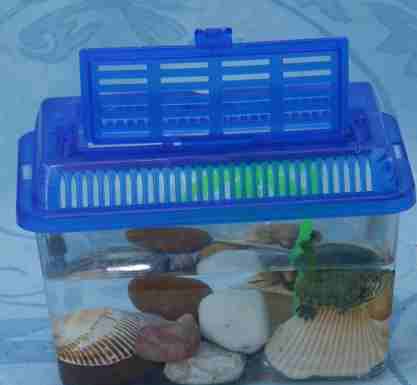
Время от времени у вас может возникать необходимость перевозить куда-то красноухую черепаху на машине (например, если вы уезжаете за город или переезжаете). Такое перемещение может стать огромным стрессом для вашей рептилии, но если вы потратите немного времени и усилий на планирование и подготовку этого процесса, есть все шансы, что процесс пройдет довольно гладко.
Коробка для перевозки
Для путешествий в машине черепаху можно поместить в пластиковую коробку (например, для хранения продуктов). В крышке коробки следует сделать несколько отверстий для вентиляции, но проследите, чтобы коробка была плотно закрыта в течение всего переезда, так как порой черепахи совершают виртуозные побеги. На дно коробки надо положить что-то мягкое, например, тряпку или полотенце (важно, чтобы на них не было свободных нитей, в которых могут запутаться когти черепахи), или же бумажные полотенца или газету. Коробка должна быть достаточно просторной, но все же не слишком большой: ведь наша задача в том, чтобы черепахе было удобно и мягко, и чтобы она чувствовала себя уверенно на протяжении всей поездки.
Как насчет воды?
Даже красноухие черепахи, большую часть времени проводящие в воде, могут какое-то время обходиться без нее. Но если вам предстоит долгое путешествие, можно побрызгать черепаху водой (не забудьте – это можно делать только в том случае, если в машине тепло). Можно также предложить черепахе попить.
Температура воздуха
Это самая большая трудность, с которой вам придется столкнуться. Положите в коробку с черепахой термометр, чтобы контролировать температуру. Если вы путешествуете в теплое время года, существует несколько вариантов, чтобы не допустить перегрева животного. Можно регулярно опрыскивать черепаху водой или смачивать подстилку: испарение воды будет иметь охлаждающий эффект. Если в вашей машине есть кондиционер, можно его включить, но будьте внимательны: не ставьте коробку прямо под струю холодного воздуха и следите за тем, чтобы ваш питомец не переохладился. Ни в коем случае не кладите лед или что-либо холодное прямо в коробку с черепахой!
Если вы перевозите черепаху в прохладную погоду, можно поставить коробку с ней в герметично закрывающуюся сумку-холодильник и поставить рядом с коробкой грелку. Но опять же, не ставьте грелку непосредственно в коробку!
Вентиляция
Если вы проделали отверстия в коробке, скорее всего, этого будет достаточно. Однако во время долгих поездок лучше периодически открывать коробку с черепахой, чтобы она проветрилась.
Еда
Поскольку черепахи спокойно могут обходиться несколько дней без еды, можно накормить вашего питомца за сутки до отъезда. В этом случае животное не будет испражняться в коробке и вам не придется его кормить во время переезда (если только ваша поездка не рассчитана на несколько дней).
Ночевка в отеле
Если вам нужно остановиться на ночь в гостинице, убедитесь заранее, что в выбранное вами заведение можно приезжать с животными. Возьмите с собой небольшой пластиковый тазик – его можно будет поставить в ванну и наполнить водой, чтобы дать черепахе возможность поплавать.
Проявите внимание к горничным и другим гостям отеля: не выпускайте черепаху в саму ванну или раковину, а также не позволяйте ей бродить по комнате, чтобы предотвратить распространение бактерий сальмонеллы. Когда вы будете собираться в дорогу утром, можно просто вылить воду из тазика с черепахой в туалет. Все поверхности, которых касалась черепаха, нужно протереть антибактериальными салфетками.
Чтобы оставить здесь комментарий, войдите или зарегистрируйтесь на сайте.
Авторизация